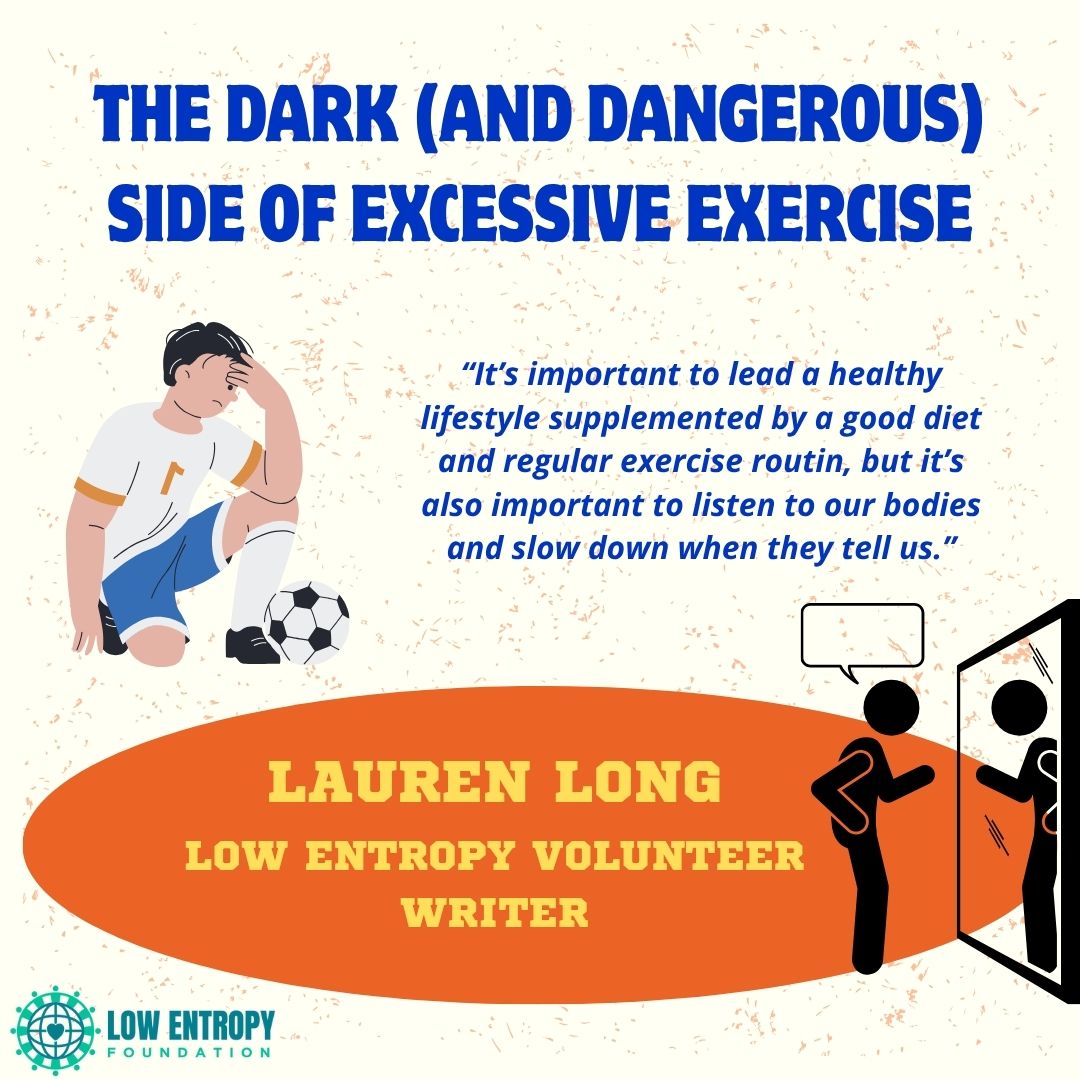Lauren Long (she/her/hers), Low Entropy Volunteer Writer
Sports and exercise have a great impact on our bodies and minds. Our physical health and mental health are closely intertwined, and it’s essential to consider what we can do to support our bodies as they support us.
Physically, regular exercise aids in the prevention of diseases, supports cardiovascular health, weight management, and bone and muscle strength. Mentally, exercise helps reduce stress, improves social well-being and mental health, and fights inactivity and reinstates balance in one’s life.
Regular exercise strengthens our hearts and increases our circulation, which in turn elevates our body’s oxygen levels. The combination of a strong heart muscle, improved circulation, and increased oxygen levels work in tandem to lower the risk of coronary artery disease, heart attacks, high blood pressure, cholesterol and triglyceride levels.
However, there is a dark side to sports and physical activity. It’s just as important to acknowledge that, while exercise and a healthy diet are essential to increasing life expectancy, our mental and physical health can be negatively affected by intensive training and excessive exercise. We also must consider how an intensive training regimen affects our lives outside of training and its influence on our relationships.
An athlete with an intensive training schedule is susceptible to the following: stress and anxiety, depression, eating disorders, substance abuse, burnout, exercise addiction, isolation, identity loss and body image influence. The pressure to win, the fear of failure and the incessant demands associated with competitions enhance an athlete’s stress and anxiety, thus affecting their sleeping patterns, attention span and appetite.
Physically, excessive exercise and intense training regimens increase the risk of injuries like sprains, fractures and muscle tears. They also play a role in the development of chronic injuries, and exhaustion caused by overtraining can lead to persistent fatigue, decreased performance, mental health issues and a weakened immune system.
So, while exercise, a healthy diet and a regular vitamin intake strengthens our immune systems, too much exercise can weaken it and our personal lives and social interactions significantly.
When an athlete’s training schedule overlaps/takes over their life, they face the following effects on relationships and school/work: time conflicts, stress and pressure, a lack of support, time dedicated to training vs. school/work, conflicting priorities and sacrificed opportunities.
I have struggled with finding the balance between my training schedule for pole dance and other areas of my daily life. There are days when I feel disappointed with myself because I see my pole friends’ videos on Instagram and think “That’s where I should be, I’ve been doing this for almost six years.”
I’ve gotten better at recognizing these thoughts and giving myself grace instead of berating myself though. I realized that I lost a lot of strength and flexibility last summer when my family and I experienced a double tragedy, and that it takes time to build that up again. My coach/instructor has been wonderful, she has supported and encouraged me the last several months as I’ve found my way back to a regular training schedule, and never once did she shame or blame me for being human and needing time to process. She also told me that learning movements wouldn’t take as long this time because my muscles would remember, and she was right! That’s the difference between a good coach and a not-so-good coach, the good ones show empathy and understanding that their students are human and need time to process and work through grief, while the less than stellar coaches do not.
The final thing I want to talk about is the impact excessive exercise can have on women’s menstrual cycles and vice versa. I’ve made a point of making the five days that I have my period each month to be a slower exercise/rest week. I learned the hard way that strenuous exercise changes my period flow from medium to heavy.
It has been scientifically proven by researchers that yoga, stretching and aerobic workouts reduce menstrual pain by 25% and exercising during menstrual cycles can improve women’s sleep and mood.
On the other hand, it has been evidenced that intense or sudden changes in physical activity can cause irregularity in menstrual cycles or missed ones altogether. These changes in a woman’s exercise routine can also have an effect on the hormones that synchronize the menstrual cycle and cause breakthrough bleeding, change in period flow and period pain.
It’s important to lead a healthy lifestyle supplemented by a good diet and regular exercise routine, but it’s also important to listen to our bodies and slow down when they tell us to. Is having an enviable figure worth potential injury, decreased mental health and negatively affected relationships? No.
—
Born and raised in Quesnel, BC, Lauren Long is a strong advocate for mental health and well-being, a voice for the pole community, a major Swiftie and a role model for positive body image. When she’s not writing, you can find her on the pole, on the training mats or curled up with a good book or fanfiction.

